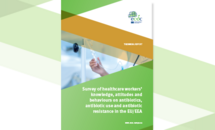Survey of healthcare workers’ knowledge, attitudes and behaviours on antibiotics, antibiotic use and antibiotic resistance in the EU/EEA
This report presents the results of the first multi-country and multi-professional study on the knowledge, attitudes and behaviours of healthcare workers regarding antibiotics, antibiotic use and antibiotic resistance across 30 European Union (EU) and European Economic Area (EEA) countries. While several studies have assessed the knowledge, attitudes and behaviours of the general public, healthcare students and individual professional groups in EU Member States, there is a lack of literature on the topic which considers the full breadth of healthcare workers.
Executive Summary
Understanding the barriers to prudent antibiotic use is vital in order to develop and deliver interventions that increase awareness and knowledge and ultimately change behaviour on antibiotic use. Based on the COM-B behavioural change model - a theoretical framework that can be used for understanding and changing behaviour - the study sought to understand the Capabilities (C), Opportunities (O) and Motivations (M) which enable prudent Behaviour (B) on antibiotic use amongst healthcare workers in EU/EEA countries. The survey findings can support strategies for policy development, education and communication campaigns targeting healthcare workers that aim to address prudent use of antibiotics, and prevention and control of antibiotic resistance in the EU/EEA.
A questionnaire was developed following a systematic literature review and a two-round modified Delphi consensus process with a Project Advisory Group (PAG) (consisting of designated country representatives and selected European health professional organisations/groups). The questionnaire was piloted across EU/EEA countries before translation into the 24 official EU languages and Norwegian.
A quota sampling approach based on the EU healthcare personnel statistics per profession and country was used to determine the target survey sample size for each country and professional group. A sample of 0.2% of the workforce was sought for each healthcare profession in each country, except for nursing professionals for whom, because of higher numbers, a sample of 0.1% of the workforce was sought. Based on these calculations, the target survey sample size was calculated as 11 929 for the EU/EEA overall.
The final questionnaire was distributed via an online survey tool by PAG members to healthcare workers in their respective countries, as well as promoted via social media with the hashtag #ECDCAntibioticSurvey. Participation was voluntary and the online questionnaire was open between 28 January to 4 March 2019.
Over 18 000 individuals responded to the questionnaire, thanks in part to the engagement of PAG members, who actively disseminated the link to the questionnaire within their professional circles. In total, 24 (80%) countries met or exceeded their target quota sample size. The number of respondents exceeded the target quota sample size for medical doctors, nursing professionals, dentists and pharmacists, but there was a lower response rate (55% of the calculated return requirement) for the group ‘other healthcare professionals’ that consisted of hospital managers, pharmacy/dental technicians and allied health professionals. This may have reflected the strong representation of certain professional groups amongst PAG members or differences in engagement between groups.
Medical doctors correctly answered all seven survey questions assessing knowledge of antibiotics, antibiotic use and antibiotic resistance more often than other healthcare professionals. Overall, the responding healthcare workers had good awareness and knowledge of the absence of effect of antibiotics in treating self-limiting conditions such as colds and influenza (97% correctly answered this question). However, there was less knowledge on the link between treatment with antibiotics and an increased risk of antibiotic-resistant infection (75%), as well as whether healthy people can carry antibiotic-resistant bacteria (88%). The three questions with the highest proportion of respondents providing the correct answer were consistent with the key messages that have been promoted across the EU/EEA for several years. However, the topics covered by the remaining four questions have not been actively promoted and could be considered in future campaigns.
Effective infection prevention and control measures are also critical to tackling antibiotic resistance, with 87% of respondents replying that they would perform hand hygiene, i.e. disinfect or wash hands, as often as recommended even if gloves had been used in contact with patients or biological material. This is in line with WHO recommendations. Nurses and nursing associates/technicians were the professions most likely to perform hand hygiene in this situation. Healthcare workers highlighted a few key barriers to providing advice and education to patients including resource constraints and time pressures, along with difficulties in ensuring that patients understand what was being discussed/advised. Among those respondents who defined themselves as prescribers, the majority agreed that antibiotic resistance is an important factor to consider when treating patients. However, the survey highlighted that ‘fear of patient deterioration or fear of complications’ is a common driver for prescribing antibiotics even when the prescriber would have preferred not to.








